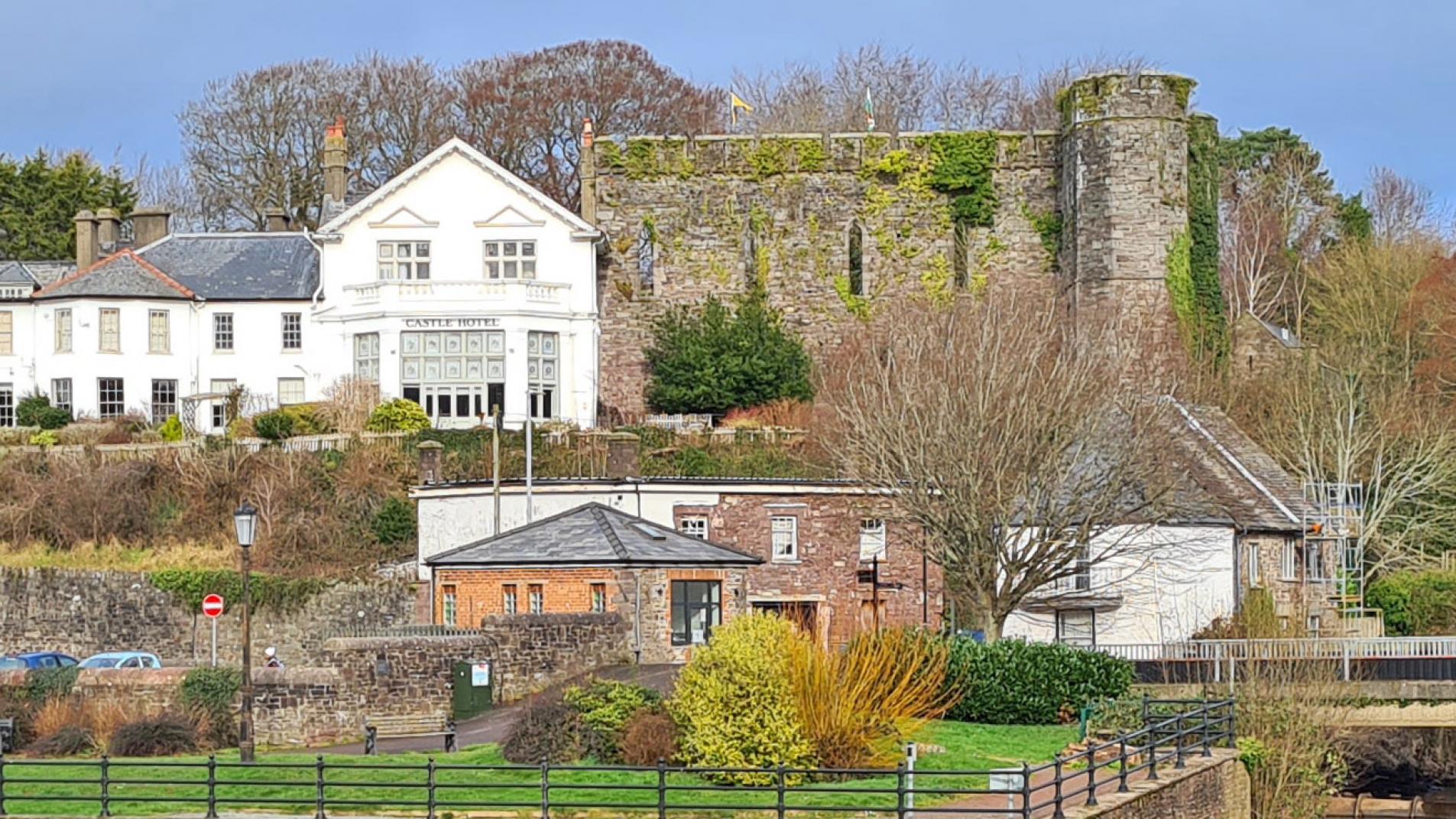
Visit historic buildings along The Postern and Castle Square. This is the 7th stop in WALK: The Brecon Story, our heritage trail around Brecon.
Postern
Turning our back on Priory House we head out of Cathedral Close through the pair of arches with beautiful wrought iron gates, cross when it is safe to do so and down Priory Hill. Take the second proper turn right into Postern.
The long low building on the left was opened in 1850 as a National School for infants and girls (the boys school being eventually at Pendre, up past the Cathedral.) Pupils were from ‘the labouring manufacturing and poorer classes.’ A few doors further along stands the Brecon Borough Gaol, which replaced one on The Struet in 1842. It still has cells with iron doors down in the basement.
The old fire station is next door with an ivy covered stone wall beyond marking the spot where the Neath and Brecon Railway crossed River Honddu, having been opened in June 1867. The houses on the right, with the arch in the middle are described on listed buildings documents as ‘Ely Place Railway Goods Station’ and a map of 1888 shows a path leading through the arch and up to a coal yard and weighing machine. The name Ely Place is still legible, carved in the keystone above the arch. Opposite, a narrow and slippery path leads down to the river and a spring, rebuilt in Victorian times and baring the name ‘Sir Charles Morgan Bart.’ on the lintel above the pool. A map of the time calls it Burffa’s Well.
Castle Square
And so we approach the site of Brecon Castle, also built by the Norman creator of the Priory, Bernard de Newmarch. It’s thought he used stone from the Gaer Roman fort to the west of Brecon for the castle. His two creations effectively marked the cornerstones of Brecon society for hundreds of years. They are still important reminders of our history.
The castle hosted many famous residents. Hugh D’espenser, a favourite of Kind Edward II was governor of the castle in 1321. A later lord, Humphrey de Bohun lived here in great splendour, turning the town into ‘the great mart of South Wales’ before dying in 1377. One of his daughters, Eleanor married a son of Edward III, another married the future Henry IV - making that King also Lord of Brecon.
If it’s winter, look up through the trees above you to see the almost hidden outline of the Ely Tower, the castle’s keep. In 1483, Henry Stafford, the Duke of Buckingham plotted here with John Morton, the Bishop of Ely, who he was holding as a prisoner, to overturn King Richard III. But their plot failed. The Duke sought sanctuary with a former servant near Shrewsbury - who instead betrayed his master in return for a reward of a thousand pounds. The Duke was taken to Salisbury and executed. On hearing the news, King Richard said: “Off with his head, so much for Buckingham.” The King then refused to pay the reward - decrying the servant’s duplicity. It’s the Duke’s son, who had the tower built at St Mary’s and suffered the same fate as his father nearly 40 years later - leaving this castle in the control of the Crown. In more recent times ‘Ely Tower’ has been the name of the home of the Bishop of Swansea and Brecon, sat behind the wall that surrounds the site.
Across the Square, we arrive at The Castle of Brecon Hotel, built by Sir Charles Morgan as The Castle Inn around a possibly 17th or 18th century Castle House alongside the remaining parts of the Castle’s 13th or 14th century Great Hall. The hall itself was being used as a five’s court by 1786: ‘as fair an inclosed court as any in England’ reported the Hereford Times. A bowling green stood nearby. Sir Charles started work in 1809 and by 1814 he had spent some £7,000 on re-building. The Castle of Brecon Hotel Company seems to have been formed in the mid 1850s, a general meeting of shareholders in 1857 hearing that trade would have been better if a lengthy drought that year had not affected the local fishing. But they had been helped by the opening of the Summer Coffee Saloon (one of the largest rooms in South Wales). A pleasure boat had been procured “which afforded manly exercise and healthy enjoyment to many visitors” with a boat house also planned.
The Hotel was made viable with the growing interest in travel around the UK by wealthy families who could no longer travel to Europe because of the French Revolution and the Napoleonic Wars. Then the growth in better rail transport boosted trade. In 1845, one enterprising coach owner offered transportation from the Hotel to London in a then record breaking 11 hours. A carriage would leave the hotel at 7am, through Abergavenny, Usk and Chepstow arriving in Bristol in time for the 3pm train to London. The fare: in third class: 21 shillings. By 1867 the travel time was cut to just 7 hours as rail lines reached into mid Wales. Regular newspaper advertising also helped - promoting the miles of fishing rights that the hotel had secured along with its beautiful views and well maintained gardens.
Brecon Castle is part of our WALK: The Brecon Story heritage trail. Click here to access the Google Earth map or visit the next place on our trail